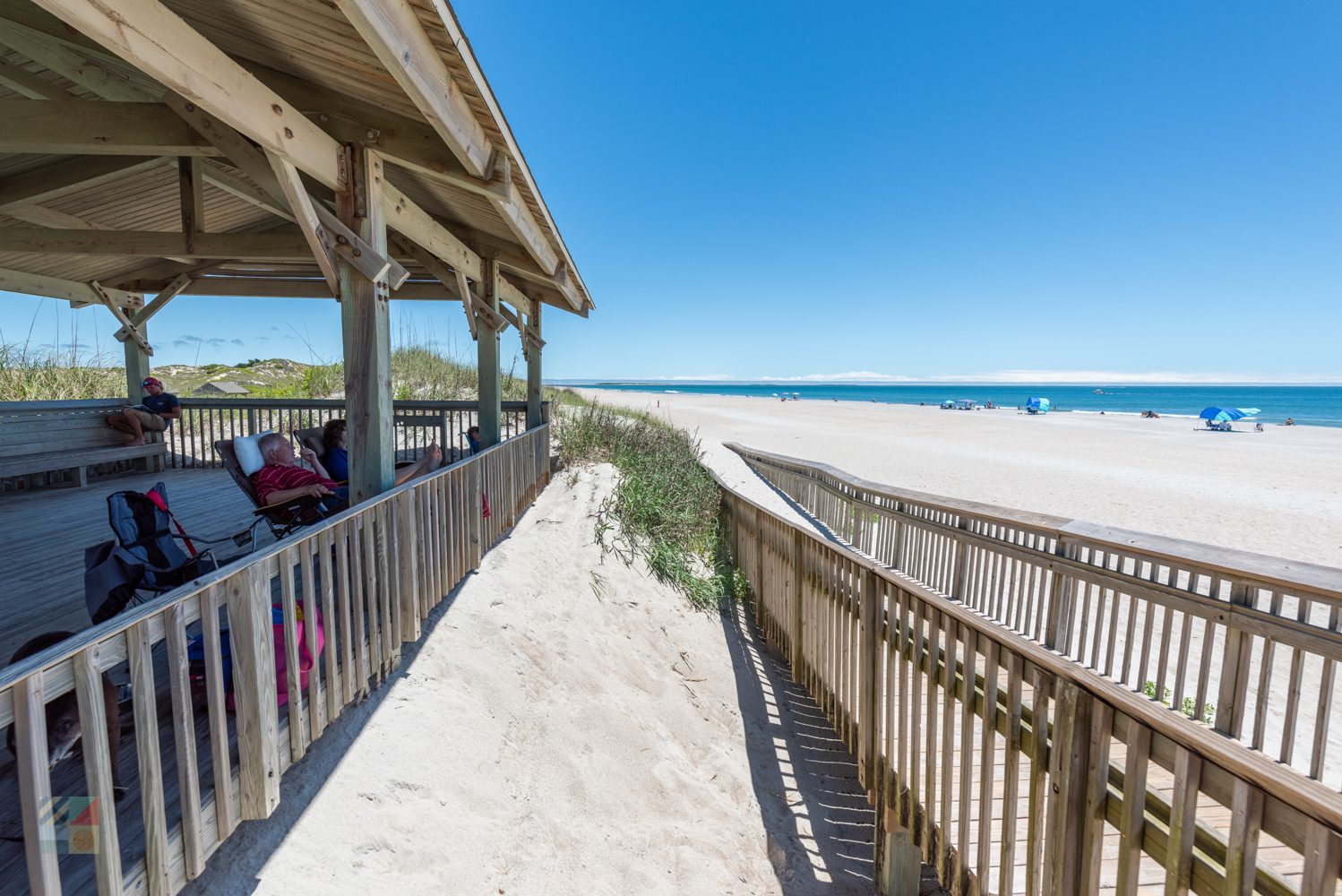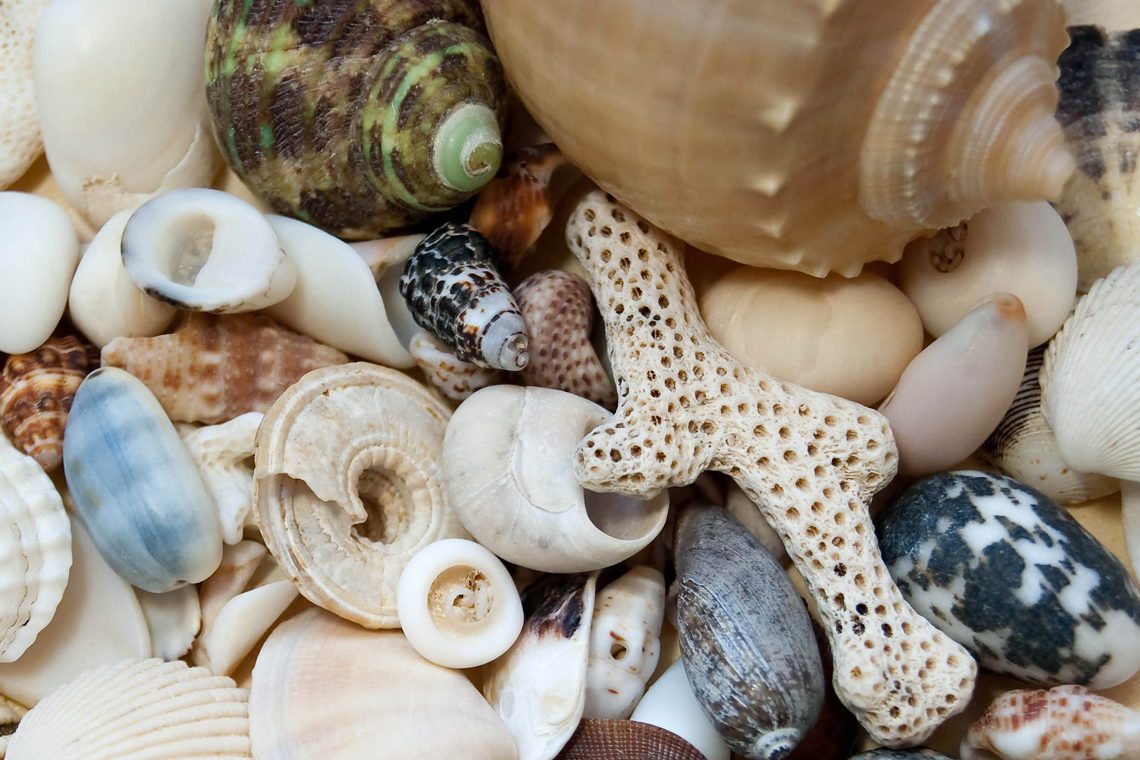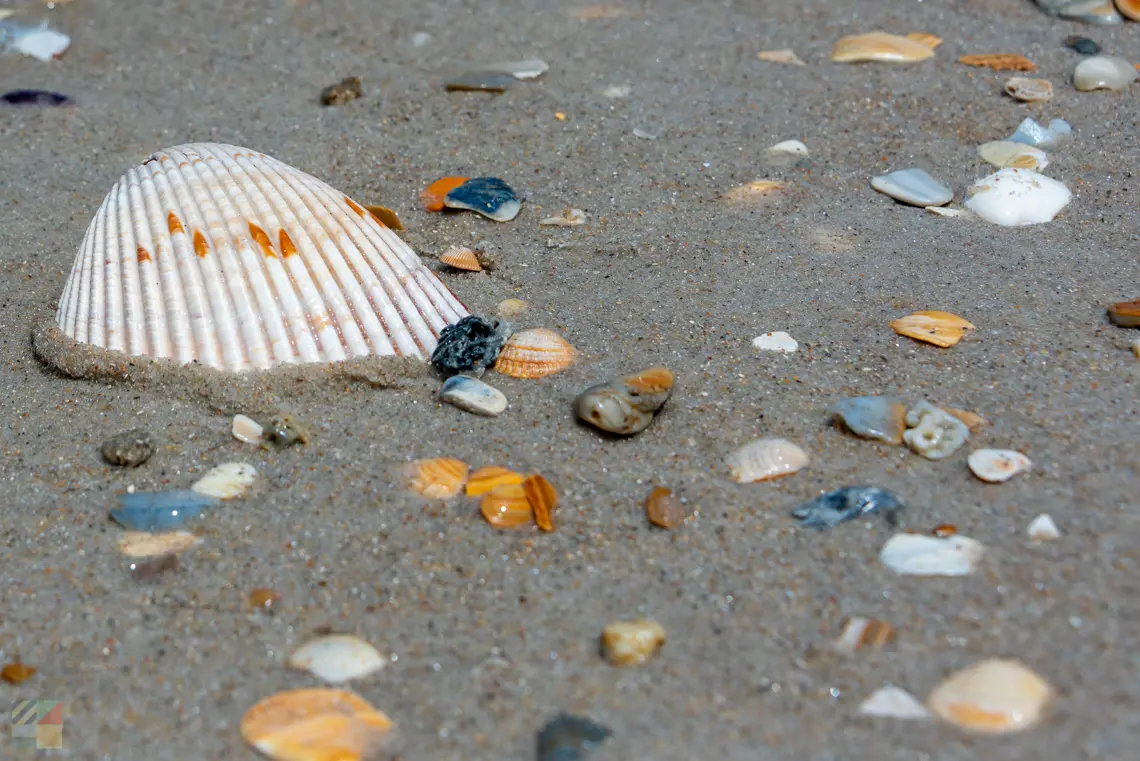One of the best attributes of Morehead City for many longtime vacationers is that this central Crystal Coast town is close to everything the Southern Outer Banks has to offer.
And when it comes to beachcombing, this means that shell seekers will be a quick drive or water taxi away from some of the most promising and coveted beaches along the North Carolina coastline.
From almost secretive destinations that are miles offshore, to busy Atlantic Beach shorelines that are wonderfully close to home, Morehead City treasure hunters will soon find that a fruitful and altogether unforgettable shelling adventure is never too far away.
Top Shelling Destinations near Morehead City
Depending on the local weather conditions, passing storms, and the popularity of a given shoreline, veritably any beach close to Morehead City - (and there are quite a few) - can be a prime destination for shell hunters.
With that being said, however, there are a few coveted and revered destinations that may require a little effort to reach, but which are well worth the trip.
South Core Banks / Cape Lookout
The South Core Banks – and particularly the southernmost point, “Cape Lookout” – is arguably the best shelling destination close to Morehead City. This isolated and completely undeveloped barrier island shoreline is part of the 56-mile long Cape Lookout National Seashore, and a proximity to two major Trans-Atlantic currents, the Gulf Stream and the Labrador Current, combined with the area’s isolation makes it a beachcomber’s paradise. Expect to find a huge variety of shells, and little competition. Because getting to this destination can be a challenge, it’s typically easy to find a wide and empty stretch of shoreline to call your own.
How to get there: Morehead City visitors can take a ferry or water taxi from neighboring Beaufort or the town of Harkers Island, which is roughly 20-40 minutes away. The ferry ride lasts around 20-45 minutes, and will deposit passengers close to the Cape Lookout Lighthouse. From here, visitors can take a “taxi ride” via a converted pick-up to the actual point of Cape Lookout, where the best shells are generally found. (Reservations are recommended.)
The Shackleford Banks, which are the southernmost portion of the Cape Lookout National Seashore, is a great bet for shell hunters due to the variety of shells and the relatively close proximity to Morehead City. Also isolated and completely undeveloped, this shoreline often has great treasures on both the soundside and oceanside beaches, as well as relatively few crowds (expect for busy summer weekends.) Arriving early will go a long way in getting the best finds, as will a long walk along the beach in search of piles of freshly washed up shells.
How to get there: Visitors can take a quick 15-20 minute water taxi ride from the neighboring town of Beaufort. Ferry service and / or tours may also be available along the Morehead City waterfront. (Reservations are recommended.)

Fort Macon State Park, which is found on the eastern borders of Atlantic Beach and which is located about a 10-15 minute drive away for Morehead City visitors, is one of the best shelling destinations along the developed Crystal Coast shoreline. With no structures except for public restrooms and the historic 1820s Fort Macon itself, this shoreline borders the Beaufort Inlet and features both sound and ocean-facing beaches where shells regularly wash ashore. The beach can get crowded in the summer months, but off-season visitors and early birds will have a great chance of acquiring an assortment of salty treasures.
How to get there: Cross the Atlantic Beach Causeway, and turn left on Highway 54 until the road ends and the entrance to the Fort Macon State Park begins. There are also additional parking options en route, and in between Atlantic Beach and the eastern edge of the island.
The Circle at Atlantic Beach is undeniably the easiest public beach access for Morehead City visitors to reach, but it is also one of the most crowded shorelines in the region. Home to seasonal lifeguards, restrooms, a playground, and a host of bordering shops and restaurants, this beach can be very popular during the height of the summer season. With that being said, early morning visitors and winter visitors will have little competition when scouring the shoreline. Also, because of recent beach nourishment projects, this destination can be an ideal destination to find tiny treasures, like augers and wentletraps.
How to get there: Cross the Atlantic Beach Causeway, and keep heading straight until you reach “The Circle” and a wide parking area. The great thing about this destination is that, depending on traffic, the entire trip to The Circle from Morehead City takes roughly 5-10 minutes at most.
Bogue Inlet, Emerald Isle
A drive to Emerald Isle may take around 20-30 minutes, depending on the traffic, but visitors who make the trek will have an opportunity to scour one of the island’s favorite beaches, the Bogue Inlet Shoreline, which is also known as simply “The Point.” This beach borders an inlet, and therefore has both sound and ocean facing shorelines, as well as the potential to attract a lot of seashells that are brought in from deeper waters with the encroaching tides. Visitors from Morehead City will only have to worry about finding a place to park. Parking is available at Emerald Isle Woods Park and the Western Ocean Regional Access, but a several mile walk may be required to reach the exact “point” of the shoreline.
How to get there: Take the Atlantic Beach Causeway to Highway 54 and turn right, passing through Atlantic Beach, Salter Path, and Indian Beach, until you reach Emerald Isle, or the westernmost edge of the barrier island shoreline.
Portsmouth Island is the northernmost section of the Cape Lookout National Seashore, and is a lone island that is roughly 15 miles long with little to no development. As a result, it’s also a prime shelling destination for a wide variety of treasures – including unusual finds like queen helmet conchs and Florida Fighting conchs. The only drawback to this destination is that it takes a while to reach, and Morehead City visitors will have to embark on a roughly 35 mile drive north before boarding a 45-minute passenger / vehicular ferry to the island.
How to get there: Drive along US Highway 70 and then head north on NC Highway 12 until you reach the small town of Atlantic. From here, head to the Morris Marina on the Pamlico Soundfront to board a vehicular / passenger ferry. (Reservations are required.)
How and When to Find Shells on the Crystal Coast
Any beachcomber worth their salt knows that any beach can turn into an exceptional shelling beach if the conditions are just right. With this in mind, visitors will want to take the following factors into consideration when planning a shell seeking adventure.
Be an early bird – Even the most isolated shelling destinations can be picked over by the time the afternoon rolls around, especially during the busy summer season. As a result, it’s smart to arrive at your beach of choice as early as possible, either by taking an early morning drive, or by booking the first ferry or water taxi of the day.
Coincide a visit with the tides – There’s a heated debate among beachcombers over which is better for shelling - a low tide or a high tide. But regardless of which tide you prefer, arriving a few minutes to an hour after the tide has passed will increase your chances of acquiring freshly washed up shells. Tide tables for the Crystal Coast region are regularly found online, and visitors can also often stop by local bait and tackle stores to pick up a paper tide table.
Watch for seasons and storms – The fall is an ideal time to go shell hunting, and especially after a hurricane or tropical system has passed through the area. In addition, visitors to Portsmouth Island and the Cape Lookout Seashore can have great luck finding shells that have washed up over the winter months if they reserve a spot on the first ferries of the season, (generally in March), especially for isolated areas like Portsmouth Island.
Mix up your shelling terrain – Can’t find any good shells on the beach? Then try wading. The beaches that surround the Crystal Coast are generally well known for their shallow, sloping shorelines, and visitors who wade out into the ocean or sound waters can often find half-buried treasures just under the surface, Use your toes to sift through the sand, (and watch for crabs!), or bring along a pair of goggles or a scuba mask to better identify underwater treasures.
Keep an eye out for shoreline abnormalities – Sandbars and deep troughs, (especially if they’re located in the same area, side by side), can result in piles of seashells being washed along the beach. Look for false “points” along the shoreline, or sandbars where shells can generally wash ashore unscathed by rough waves. Just use caution when wading – these seashore abnormalities can result in great finds, but they can also produce rip currents as well.
Types of Shells in North Carolina
North Carolina has a surprisingly varied collection of seashells that can regularly – or sporadically – wash up along the shoreline. While there are dozens if not hundreds of different varieties, shell seekers will want to keep an eye out for these popular and treasured species.
Scotch Bonnets – The Scotch Bonnet is the state shell of North Carolina, and is also, surprisingly, a bit of a rare find along the Carolina beaches. This shell is identified by its fat, cylindrical body with a short spiral, and a wide mouth (or opening) that is capped off with a thick lip. Measuring roughly 1” – 3” long on average, a “fresh” Scotch Bonnet is white in appearance with a scattering of brown square specks. (Beachcombers should note that Scotch Bonnets, as well as any shell, can also come in a variety of colors based on the age of the shell, and the types of sand – like tar – that it was submerged in before it washed ashore.)
Whelks – Whelks are often misidentified as conchs, and it’s an easy mistake to make. Similar to conchs, a whelk has a large body with a spiral, an equally large opening, and a cylindrical appearance. However, whelks are more angular, with small spikes near the spiral, and a more elongated body. (It’s also far more common to find a whelk than a conch along the Crystal Coast and the Outer Banks.) Whelks come in three varieties along North Carolina – the lightning whelk, the knobbed whelk, and the channel whelk – and can range from small, 1” specimens to huge shells that are 12” long or more.
Conchs – A conch, (like the Florida Fighting Conch, or the Queen Helmet Conch, or the Tulip Conch), is a rare find along the North Carolina shoreline, and is usually acquired on isolated beaches like the Cape Lookout National Seashore. Known for their spirals, large openings, and intricate details, a conch is a great treasure that should be prized by any beachcomber. Look for conchs after a storm, in an isolated area, or in slightly deeper waters where they can be partially submerged in the sandy ocean floor.
Olive shells – an olive shell is a relatively common but beautiful find that can be spotted throughout the Crystal Coast shoreline. Measuring just 1-3” long or so, with a long tapered body and equally long opening that caps off with a tight spiral, these shells can be found in the sound waters, ocean waters, or in piles of shells that have freshly washed ashore. A “fresh” olive shell is the most appealing for beachcombers, as its exterior is a shiny splash of brown patterns, and the interior is a vibrant violet color.
Augers, periwinkles, wentletraps, and oyster drillers – These small, spiral shells are often spotted in large piles of shells, or buried in piles of seaweed along the shoreline. Measuring 1” or even smaller, these tiny finds are distinctly ornamental and are prized - albeit smaller - treasures for avid beachcombers.
Moon snails, aka, shark eyes – a moon snail is another spiral shell that is distinct for its fat and almost completely circular body, as well as its spiral that dwindles in size until it reaches the center of the shell. Fairly common but attractive nonetheless, moon snails can range from 1” or less in size to a whopping 4-5” wide, and can be found along virtually any oceanside beach within the Crystal Coast.
Scallops - scallops are common in North Carolina, but are prized by beachcombers for their often distinctive patterns and ornamental use for crafts. The most coveted scallops are also the brightest, with specks of pink, rose, and even yellow on an otherwise circular body with two ridged fins. Scallops can be found everywhere, and live or whole scallops are most commonly found in sound waters.
Razor clams, arch clams or “angel’s wings,” coquinas, oysters, and other shells – These common bivalve mollusks can be almost always along the Crystal Coast beaches, but there are a few stand-outs in the crowd that beachcombers will want to be on the lookout for. The translucent and beautiful pen shell is a delicate find that rarely makes it to shore intact, as is the thin and pristine white “angle wing.” These shells can be commonly found everywhere, but the more delicate finds often wash up days after a storm, when the water is clear and calm.
Coquinas – Coquinas can take a beachcomber by surprise, simply by the way they frequent the ocean wash just yards away from where the waves break. In the summer months, these colorful clams that come in a rainbow of hues and which measure just ½” - 1” at the most can be spotted digging in and out of the shoreline by the hundreds, creating an incredible effect that impress any beachcomber. The shells may wash ashore regularly, but spotting the “live show” is an event that truly steals the beach scene.
Sand dollars – Sand dollars are not technically a shell, but they are still a prized find for many Carolina beachcombers simply because of their delicate structure, and therefore, the rarity of having one wash up on the beach intact. Look for the pristine white sand dollars as keepers – the brown, greenish, or “fuzzy” ones with sea urchin-like, tiny points are likely still alive and should be tossed back in the water.
Learning More about North Carolina Shells
Morehead City visitors will soon discover that there are several resources at their disposal to learn more about the local shells of North Carolina and beyond.
The North Carolina Maritime Museum in the neighboring town of Beaufort has an entire room that is dedicated to seashells of the world, and which has shells from roughly 100 countries from all across the globe, as well as local finds that regional beachcombers will have an easier time identifying.
The National Park Service Visitors Centers for the Cape Lookout National Seashore – which are found on Harkers Island, near the Cape Lookout Lighthouse, and on Portsmouth Island within the historic Portsmouth Village – are all great resources for visitors who want to identify a recent find. Staffed with area park rangers, the friendly folks at the visitors centers can help point beachcombers in the right direction for finding shells, and can answer questions on what an unusual find may be.
Finally, visitors can stop by the Crystal Coast Tourism Authority in the heart of Morehead City for a wealth of information on the local beaches, shelling tours and water taxis, passenger or vehicular ferries, and many other shell-related facts. This all-encompassing destination covers just about everything that the Crystal Coast has to offer, and that certainly includes the area’s outstanding beachcombing possibilities.
Other Tips for North Carolina Shell Seekers
- Want to expand a treasure hunt? Then look for sea glass. Sea glass is gaining popularity as one of the most south-after beach finds, and the small and brilliantly colored bits of glass can be used in a variety of ways, from décor to jewelry.
- A shelling cruise is an exceptional way for visitors to ensure they reach the best destinations for seashells. Tours are readily available from charter boat businesses along Downtown Beaufort’s Front Street, and may be available along the Morehead City waterfront as well.
- Shell seekers can cover more ground with a 4WD vehicle. Off-season beach driving permits are available for certain regions of the developed Crystal Coast shoreline, and the Cape Lookout National Seashore is 4WD vehicle accessible as well, provided that visitors reserve a vehicular ferry that departs from the town of Davis to the South Core Banks, (aka, Cape Lookout), or the town of Atlantic to the North Core Banks, (aka, Portsmouth Island.)
- Come prepared if you’re going to an isolated shelling destination. The Cape Lookout National Seashore is exceptional for beachcombing, but there are limited resources available for visitors, which includes a general lack of water, food, and supplies. Bring bug spray and everything you’ll need for a full day on the beach.
- Check your shells for any local residents. Many perfectly whole shells found along the soundside are already occupied by local hermit crabs, so be sure you look deep inside the mouth or interior of the shell to ensure it hasn’t already been claimed.
- Watch for windy and choppy days – When the ocean is rough, only big clunky pieces of shells wash ashore. Try to correspond a beach trip when the weather is calm for a more enjoyable experience throughout.
- Take your time, and linger. Digging through a shell pile for smaller gems, or checking under piles of seaweed, can often lead to great treasures that other people have missed. So relax, and enjoy the experience! Shell hunting should be a day at the beach, after all.
Because of Morehead City’s fantastic location that’s close to miles of shorelines, it’s a prime launching point for veritably any shelling adventure. Take an expedition to an isolated barrier island shoreline, or check out the finds with ease at a local popular beach, and see how rewarding – and genuinely fun – a North Carolina shelling vacation can be.
Jump aboard the pirate ship "REVENGE" at 600 Front Street in Beaufort, North Carolina. Our interactive voyages offer fun and adventure for families and swashbucklers of all ages. Come join our crew, take part in a pirate adventure, and enjoy festive...
Founded as the world's first hang gliding school in 1974, Kitty Hawk Kites has grown into a beloved retail and outdoor recreation venture with more than 28 locations up and down the east coast! With more than 50 years of teaching the world to fly...
The Crystal Coast is best explored from the water, and Morehead City Ferry Service will take explorers to some of the most remote and beautiful corners of this long stretch of Southern Outer Banks shoreline. Launching from the heart of Downtown...
Visitors can enjoy the Crystal Coast’s most coveted and hard-to-reach shorelines, or just embark on a breezy cruise of the open waters in search of dolphins and sunsets, with a trip that’s guided by Lookout Cruises. This local tour...
Take a quick and scenic ferry ride with your experienced guide over to the pristine Outer Banks Island of Shackleford Banks, which is part of the Cape Lookout National Seashore. There, you are introduced to the wild horses of Shackleford...






